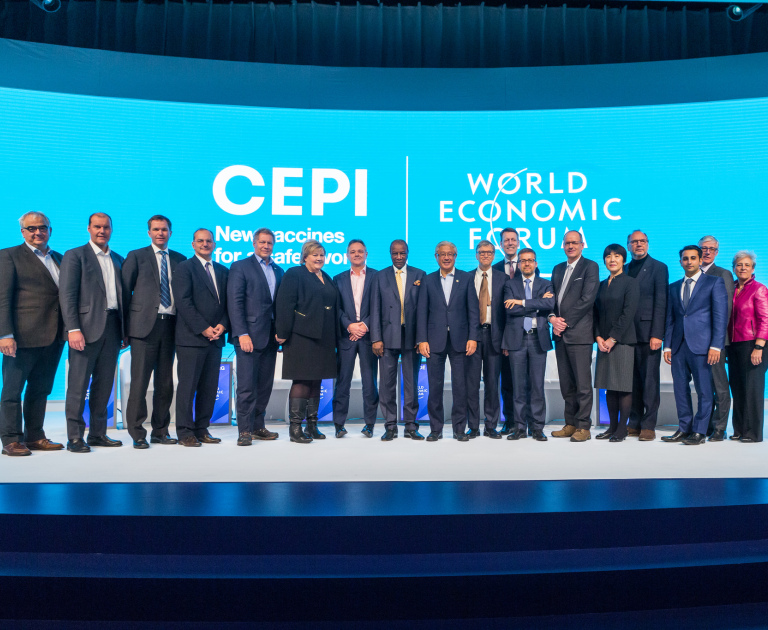Coalition for Epidemic Preparedness Innovations (CEPI)
- Founded
- 2017
- Governance
- CEPI has a governing body consisting of twelve eligible voting members and five observers. The voting members are four investors and eight independent members representing different competencies. Two advisory groups support the board: the Scientific Advisory Committee and the Joint Coordination Group.
- Funding
- CEPI recieves funding from governments, private investors, and foundations like the Bill & Melinda Gates Foundation and Wellcome. CEPI launched a USD 3.5 billion plan for its activities in 2022-2027, which is currently only partially covered.
- Description
The Coalition for Epidemic Preparedness Innovations (CEPI) is a foundation based in Norway that aims to counter current and future epidemic and pandemic threats through supporting and financing the development of vaccines and other medical products. After the global failure to adequately react to the Ebola outbreak in West-Africa, heads of governments suggested that an international organisation should be set up in order to accelerate and coordinate the development of vaccines and to enable access to these products. This resulted in the creation of CEPI in 2017.
CEPI’s planned activities for the next 5 years are focused on funding of late stage Covid-19 vaccine candidates, funding of research in prioritised pathogens (e.g. Chikungunya, Lassa Fever and MERS), and collaborating with vaccine developers to create prototype vaccines for ‘Disease X’, a novel or unanticipated pathogen. CEPI currently funds research up to phase two clinical trials, but it has expressed intention to also invest in later phases of research and development (R&D).
In order to promote global access of medical products developed with CEPI funding, it has set up an equitable access policy guide. This document should act as guideline in developing contractual agreements with developers of pharmaceutical products that receive CEPI funding. The first version of this guide was more extensive and detailed than the current version. Each contractual agreement between CEPI and a pharmaceutical company is now negotiated on a case-by-case basis. Therefore, the results of the contractual clauses on transparency, pricing and availability differ per pharmaceutical company.
During the Covid-19 pandemic, CEPI has invested in the R&D of fourteen different vaccine candidates, including those from Oxford/AstraZeneca, Clover Biopharmaceuticals, Moderna and SK Biosciences.

Strengths
- Has gained substantial financial support and can therefore accelerate the development of new vaccines.
- Because of CEPI’s large financial contributions to R&D of new vaccines, it has the potential to improve equitable access by attaching conditions to this funding.
Weaknesses
- The current equitable access policy guide provides insufficient tools for CEPI to negotiate meaningful contractual clauses on affordability, availability, transparency, sharing of intellectual property and promoting local manufacturing capacity in low- and middle-income countries.
- Maintains power imbalance between the global north and south because of a lack of support from CEPI for sharing of intellectual property and know-how with low- and middle-income countries, for instance through the Covid-19 Technology Access Pool (C-TAP) or the mRNA hub.
Review
With the amount of financial and political support that CEPI has gathered in the few years of its existence, it has the potential to substantially change the funding landscape of future vaccines. CEPI could in theory improve the sufficiency, urgency, sustainability and power balance in the response to pandemics through the research and development projects it funds. Unfortunately, the full potential of CEPI remains untapped, largely due to the inadequate conditions it attaches to its funding.
The early equitable access policy guide that CEPI had in place was well equipped to make sure that agreements with pharmaceutical companies guaranteed equitable global access. Unfortunately, this version of the guide was quickly changed into a small 2-page policy document that did not provide CEPI with clear demands that should be included in the contractual agreements.
In the first version of the equitable access policy guide, it stated that CEPI would set boundaries for the price of the licensed vaccine. This is in contrast to the later adopted version that states that prices will be set in collaboration with others in the global health community. This new version contains similar dilutions of policies on affordability, availability and intellectual property.
We therefore recommend CEPI to reinstate their original equitable access policy guide. Additionally, we recommend CEPI to draft a template for licensing agreements that should include language on affordability, availability, manufacturing capacity in low- and middle-income countries and transparency of prices. This template should act as a bare minimum, therefore preventing that case-by-case negotiations with pharmaceutical companies drop below an acceptable threshold.
In order to promote countries’ self-reliance and to restore power balances between the global north and south, CEPI should include more focus on the sharing of technology and know-how with manufacturers in low- and middle-income settings, for instance through C-TAP or the mRNA hub.